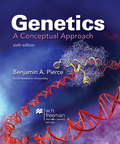
a.
To explain:
The type of chromosome mutations required to change the chromosome
Introduction:
Chromosomal rearrangements are the mutations in chromosomes that alter the structures of individual chromosomes. The four types of chromosomal rearrangements are deletions, duplications, translocations, and inversions.
a.
Explanation of Solution
Duplication is a type of mutation, which results in the duplication or doubling of some part of the chromosome. For the conversion of
b.
To explain:
The type of chromosome mutations required to change the chromosome
Introduction:
Chromosomal rearrangements are the mutations in chromosomes that alter the structures of individual chromosomes. The four types of chromosomal rearrangements are deletions, duplications, translocations, and inversions.
b.
Explanation of Solution
Duplication is a type of mutation which results in duplication or doubling of some part of the chromosome. For the conversion of
c.
To explain:
The type of chromosome mutations required to change the chromosome
Introduction:
Chromosomal rearrangements are the mutations in chromosomes that alter the structures of individual chromosomes. The four types of chromosomal rearrangements are deletions, duplications, translocations, and inversions.
c.
Explanation of Solution
Inversion is a type of chromosomal rearrangement mutation which involves inversion of a segment of chromosome to
d.
To explain:
The type of chromosome mutations required to change the chromosome
Introduction:
Chromosomal rearrangements are the mutations in chromosomes that alter the structures of individual chromosomes. The four types of chromosomal rearrangements are deletions, duplications, translocations, and inversions.
d.
Explanation of Solution
In deletion mutation, some part of the chromosome gets deleted which results in shortening of chromosome. For the conversion of
e.
To explain:
The type of chromosome mutations required to change the chromosome
Introduction:
Chromosomal rearrangements are the mutations in chromosomes that alter the structures of individual chromosomes. The four types of chromosomal rearrangements are deletions, duplications, translocations, and inversions.
e.
Explanation of Solution
In deletion mutation, some part of the chromosome gets deleted which results in shortening of chromosome. For the conversion of
f.
To explain:
The type of chromosome mutations required to change the chromosome
Introduction:
Chromosomal rearrangements are the mutations in chromosomes that alter the structures of individual chromosomes. The four types of chromosomal rearrangements are deletions, duplications, translocations, and inversions.
f.
Explanation of Solution
The inversion mutation involves inversion of a segment of chromosome to
g.
To explain:
The type of chromosome mutations required to change the chromosome
Introduction:
Chromosomal rearrangements are the mutations in chromosomes that alter the structures of individual chromosomes. The four types of chromosomal rearrangements are deletions, duplications, translocations, and inversions.
g.
Explanation of Solution
The inversion mutation involves inversion of a segment of chromosome to
h.
To explain:
The type of chromosome mutations required to change the chromosome
Introduction:
Chromosomal rearrangements are the mutations in chromosomes that alter the structures of individual chromosomes. The four types of chromosomal rearrangements are deletions, duplications, translocations, and inversions.
h.
Explanation of Solution
For the conversion of
i.
To explain:
The type of chromosome mutations required to change the chromosome
Introduction:
Chromosomal rearrangements are the mutations in chromosomes that alter the structures of individual chromosomes. The four types of chromosomal rearrangements are deletions, duplications, translocations, and inversions.
i.
Explanation of Solution
For the conversion of
Chromosomal rearrangements include deletion, inversion, duplication, and translocation. For the conversion of segment of chromosome into another, one or more than one type of chromosomal rearrangement takes place.
Want to see more full solutions like this?
Chapter 8 Solutions
Genetics: A Conceptual Approach
- 22. Which of the following mutant proteins is expected to have a dominant negative effect when over- expressed in normal cells? a. mutant PI3-kinase that lacks the SH2 domain but retains the kinase function b. mutant Grb2 protein that cannot bind to RTK c. mutant RTK that lacks the extracellular domain d. mutant PDK that has the PH domain but lost the kinase function e. all of the abovearrow_forwardWhat is the label ?arrow_forwardCan you described the image? Can you explain the question as well their answer and how to get to an answer to an problem like this?arrow_forward
- Describe the principle of homeostasis.arrow_forwardExplain how the hormones of the glands listed below travel around the body to target organs and tissues : Pituitary gland Hypothalamus Thyroid Parathyroid Adrenal Pineal Pancreas(islets of langerhans) Gonads (testes and ovaries) Placentaarrow_forwardWhat are the functions of the hormones produced in the glands listed below: Pituitary gland Hypothalamus Thyroid Parathyroid Adrenal Pineal Pancreas(islets of langerhans) Gonads (testes and ovaries) Placentaarrow_forward
 Human Anatomy & Physiology (11th Edition)BiologyISBN:9780134580999Author:Elaine N. Marieb, Katja N. HoehnPublisher:PEARSON
Human Anatomy & Physiology (11th Edition)BiologyISBN:9780134580999Author:Elaine N. Marieb, Katja N. HoehnPublisher:PEARSON Biology 2eBiologyISBN:9781947172517Author:Matthew Douglas, Jung Choi, Mary Ann ClarkPublisher:OpenStax
Biology 2eBiologyISBN:9781947172517Author:Matthew Douglas, Jung Choi, Mary Ann ClarkPublisher:OpenStax Anatomy & PhysiologyBiologyISBN:9781259398629Author:McKinley, Michael P., O'loughlin, Valerie Dean, Bidle, Theresa StouterPublisher:Mcgraw Hill Education,
Anatomy & PhysiologyBiologyISBN:9781259398629Author:McKinley, Michael P., O'loughlin, Valerie Dean, Bidle, Theresa StouterPublisher:Mcgraw Hill Education, Molecular Biology of the Cell (Sixth Edition)BiologyISBN:9780815344322Author:Bruce Alberts, Alexander D. Johnson, Julian Lewis, David Morgan, Martin Raff, Keith Roberts, Peter WalterPublisher:W. W. Norton & Company
Molecular Biology of the Cell (Sixth Edition)BiologyISBN:9780815344322Author:Bruce Alberts, Alexander D. Johnson, Julian Lewis, David Morgan, Martin Raff, Keith Roberts, Peter WalterPublisher:W. W. Norton & Company Laboratory Manual For Human Anatomy & PhysiologyBiologyISBN:9781260159363Author:Martin, Terry R., Prentice-craver, CynthiaPublisher:McGraw-Hill Publishing Co.
Laboratory Manual For Human Anatomy & PhysiologyBiologyISBN:9781260159363Author:Martin, Terry R., Prentice-craver, CynthiaPublisher:McGraw-Hill Publishing Co. Inquiry Into Life (16th Edition)BiologyISBN:9781260231700Author:Sylvia S. Mader, Michael WindelspechtPublisher:McGraw Hill Education
Inquiry Into Life (16th Edition)BiologyISBN:9781260231700Author:Sylvia S. Mader, Michael WindelspechtPublisher:McGraw Hill Education





